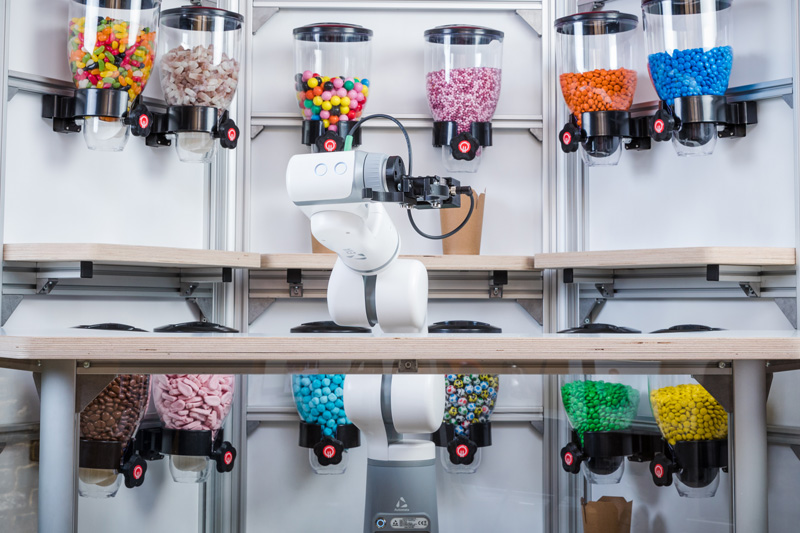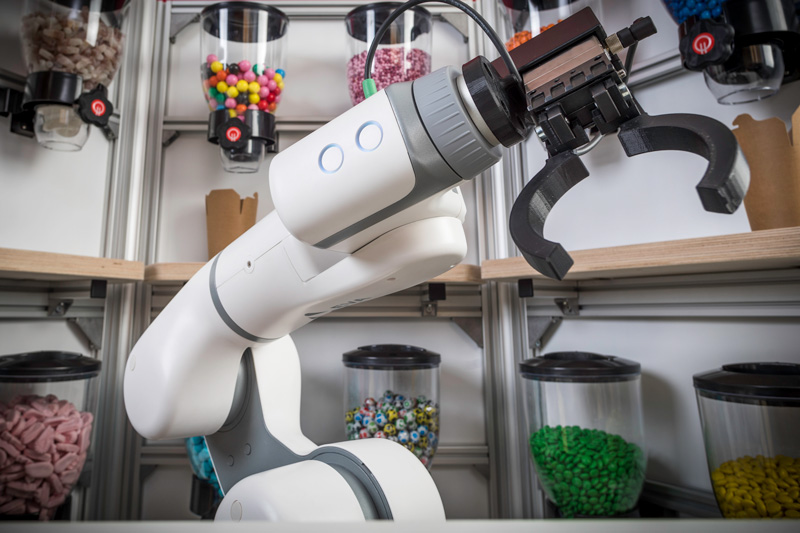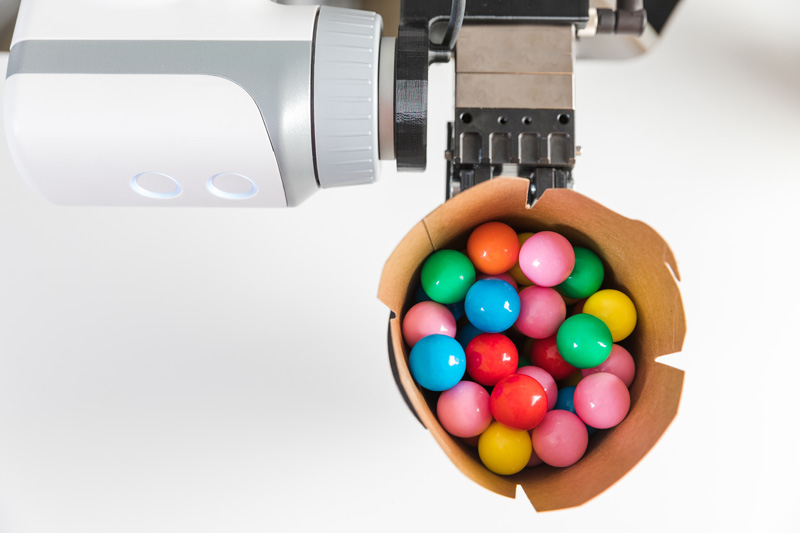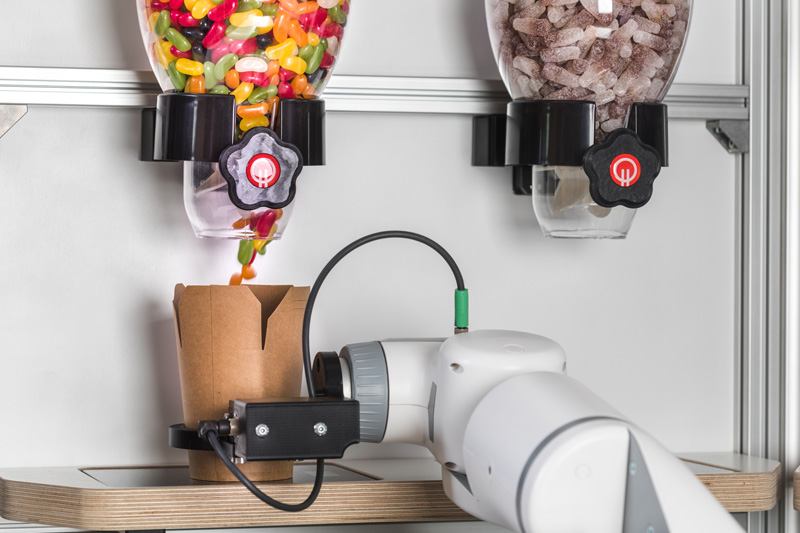Robotics
Bot Appétit!
How Karakuri Robots Are Bringing Hyper-Personalisation to Food
Ocado-backed Karakuri is taking on a challenge many others have failed at: introducing robots to the food service industry. Ellen Daniel speaks to CEO and co-founder Barney Wragg to find out how the company is making hyper-personalisation work for restaurants and catering

Consumers are increasingly demanding a higher level of personalisation from the brands they engage with, and the food industry is no different. According to research by Epsilon, 80% of customers are more likely to purchase a product or service from brands that provide personalised services.
However, when it comes to food, providing this level of service can be time-consuming and labour intensive. Robotics could provide the answer to this, allowing customers to hyper-personalise their orders, be it by size, ingredients, nutritional value, or to meet specific dietary requirements.
The concept of food-making robots is not new, but has not always been a success. In 2018, “Flippy” the burger flipping robot was installed at a branch of US food chain Cali Burger. However, Flippy was switched off after just one day due to being too slow.
Karakuri does not seem to be facing the same misfortune. Since launching in 2018, it has raised £7m in seed funding, with investors including online supermarket Ocado, and also announced that six Michelin-starred chef Heston Blumenthal has joined the company as a board advisor.
CEO and co-founder Barney Wragg said that the Karakuri, which takes its name from a traditional mechanical Japanese puppet, was born out of a hurdle facing the restaurant and catering industry:
“The company came about as I was starting to work with some friends in and around the restaurant industry, and could see looking at their businesses the difficulties they were having making ends meet and running businesses in the current market. There's a huge customer demand but also very demanding customers.
“Customers are expecting more and more from their takeaway food and from meals served to them in a restaurant in terms of their ability to customise that: alter what's on the menu; change what's there; specify what they want, use high quality ingredients.
“All of which is really pushing at the cost for restauranteurs who are in parallel seeing an incredible shortage of good labour in the market. It is very difficult to recruit and even retain people when there's a lot more options for people to work in casual labour than there used to be.”

Introducing Industry 4.0 to food
Before founding Karakuri, Wragg worked across the tech and entertainment industry for companies including chip manufacturer ARM and Universal Music, but observed that the benefits industry 4.0 was bringing to manufacturing could be applied to the restaurant industry.
Industry 4.0 refers to the use of automation and data to improve efficiency in manufacturing and has been a key element of the industry for several years now, with 76% of manufacturers having some form of digital factory initiative, according to the Capgemini Research Institute.
However, the restaurant and commercial catering industry has been slower to embrace this trend, according to Wragg.
“When you do anything with food, it's a very nonlinear product and a very nonlinear process, so every piece of fish, chicken, grain of rice, vegetable you get is slightly different to the previous one.
“With food because it's nonlinear you need to have a smarter system, you need to take feedback from sensors, and adapt how it behaves to deal with the different types of food that it is processing. That's what's made it difficult. And I think we're only just coming to the point now where the technology is widely available that allows that to happen.
“When you draw parallels with what has happened in other manufacturing sectors, then you start to think about restaurants as being a small volume, highly customisable manufacturing plant.”
“When you do anything with food, it's a very nonlinear product and a very nonlinear process.”
In embracing the fourth industrial revolution for food, Karakuri has developed off-the-shelf robots, similar to those used in manufacturing, and currently has two models.
Marley, pictured throughout the article, is designed for low throughput applications and can dispense precise quantities of different items, such as sweets, ice-cream or cocktails, making it easier to know exact quantities and avoid cross-contamination.
DK1 is a progression of this, designed for canteen style service at a much larger scale. It can hold up to 48 different ingredients, which are then dispensed to create dishes that can be customised to fulfil unique dietary requirements, producing one meal every ten seconds.
Powering hyper-personalisation in hospitality with robots
Wragg believes that there is a growing demand for hyper-personalisation, with those in the restaurant industry under pressure to implement this at scale. According to a survey by hospitality group Seven Rooms, 48% of consumers would be willing to hand over their data for a more personalised experienced.
“People are looking for fresher, better, more organic. They want to understand where their food's come from. They want to understand the traceability of it,” he explains.
“They want more control over what it is that they're eating, either in specifying their allergens or their dietary preferences, or the source of where their food has come from. So I think customer expectations have increased significantly and that's a major trend that's happening across the industry.”
“Customer expectations have increased significantly and that's a major trend that's happening across the industry.”
Karakuri’s robots work by allowing customers to interact with a restaurant’s menu via an app, and then decide the exact portion size of each ingredient they want in their meal.
Machine sensing allows data on quantities and qualities of foods used in each meal unlocked, making It possible to predict future requirements.

Taking on food waste with robotics
Wragg explains that this level of precision does not only benefit the consumer, but can also help those in the industry tackle the urgent issue of food waste.
The quantity of food thrown away each year is expected to rise by a third by 2030 to 2.1bn tonnes. According to research by Champions 12.3, a coalition of executives from governments and businesses, restaurants could make a profit of £7 for every £1 they invest in measures to reduce food waste. By avoiding over-preparing, reducing the risk of customers being served the wrong food, and allowing restaurants to know the precise quantities of ingredients they are using, automation can help alleviate this.
“The biggest impact is food waste. The carbon footprint of an order being made wrong inside a restaurant is horrendous. The profitability of that for an operator is horrendous. And that could simply be somebody putting the wrong ingredients onto a plate or into somebody's meal box. And so doing things which stop that happening or cut down on that have a huge impact.
“Secondarily, by trying to optimise and make your production process as efficient as possible, you're also looking at what you need for refrigeration, what you need for heating, when you need that heating, and you're able, to some extent, [to] make an impact on that as well.”
“The carbon footprint of an order being made wrong inside a restaurant is horrendous.”
Wragg also believes that robotics can help restaurants cater to dietary requirements and allergies without error. In 2018, Pret A Manger faced widespread criticism after a customer died from an allergic reaction to a sandwich sold by the chain, which was allegedly contaminated with dairy. When automation is involved, error becomes far less likely:
“Very simply, robots are very good at not making mistakes, so with DK1 we can serve a number of different ingredients, and we know exactly what's provisioned from each dispenser into which bowl, plate or box at what time and how much has gone in.
“We don't run the risk in a busy time of a member of staff accidentally taking a spoon out of a sauce and using it to scoop something that's had salad in it because our robots are not configured to do that.”
Automation in food: A threat to staffing levels?
However, when it comes to automation, the inevitable fears over the loss of human jobs are never far away. Currently, Karakuri’s robots only automate one aspect of the meal preparation process, and Wragg says that innovation is not about reducing headcount in the kitchen:
“We're working with a number of major restaurant chains and ironically in every single case, they're not interested in reducing headcount. They're all very happy with their headcount, but they are all incredibly motivated to reduce their staff churn.
“Some of them are recruiting four or five times a year for the same role. And that has a massive impact financially in terms of recruitment costs. It's about utilising people in a way that's going to provide them with an interesting and more fulfilling role, taking away the jobs that people just don't want to do.”

Robots’ place in the future of commercial kitchens
Looking to the future, Wragg believes that automation will become a common feature of commercial kitchens. New startups, such as Bear Robotics which has developed a food service robot, called Penny, that shuttles food and drink to customers, and Seattle-based startup Picnic which has developed an automated pizza assembly robot, have emerged alongside Karakuri, as the industry continues to invest in automation.
“Our expectation is that it's going to become commonplace in every commercial kitchen,” says Wragg.
“We think the level of services that can be achieved, and the efficiency both from a sustainability point of view and from a profitability point of view will mean that it becomes part of everyday life over the next five to 10 years.”
“Our expectation is that it's going to become commonplace in every commercial kitchen.”
However, he does not predict that kitchens will ever operate entirely without human input. He envisions that entirely human-run kitchens may exist to serve a more high-end market, but for the repetitive elements of food preparation, automation holds great promise:
“There will always be some degree of human element. There will always be the artisanal restaurant where everything is done by hand. But you'll pay price for that service. And we're not in any way trying to take that away.
“In fact, what we're trying to do is find ways where you can use more human creativity because you take human time away from doing the less creative, boring, repetitive tasks.”
Back to top